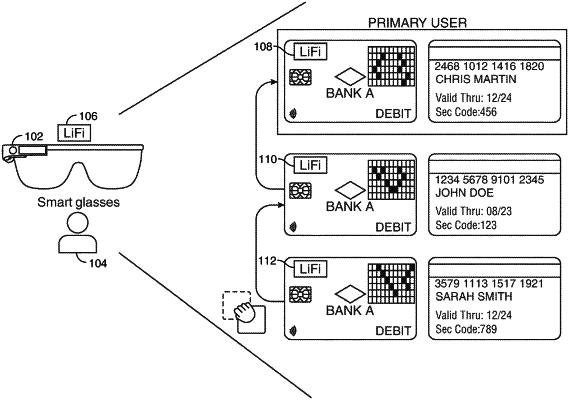| CPC G06Q 20/3276 (2013.01) [G02B 27/0172 (2013.01); G06F 3/017 (2013.01); G06F 3/0486 (2013.01); G06F 3/0488 (2013.01); G06F 3/04842 (2013.01); G06Q 20/341 (2013.01); G06V 20/20 (2022.01); G02B 2027/014 (2013.01); G02B 2027/0138 (2013.01); G02B 2027/0178 (2013.01)] | 20 Claims |

|
1. A method for using smart glasses to initiate a transaction between a first smart card and a second smart card, the method comprising:
detecting, using a smart glasses camera, the first smart card and the second smart card within a field of view (“FOV”) of the smart glasses;
capturing, using the smart glasses camera, an image of the detected first smart card and an image of the detected second smart card;
extracting, using a microprocessor, first identification data from the first smart card and second identification data from the second smart card;
using the smart glasses, displaying a first augmented reality display;
capturing, using a smart glasses camera, a motion associated with a selection, the selection configured to initiate a transaction in the first augmented reality display;
in response to the capturing, retrieving, by a smart glasses light fidelity (“Lifi”) receptor:
a first erasable programmable read-only memory (“EPROM”) array pattern embedded in an EPROM on the first smart card, the first EPROM array pattern transmitted to the smart glasses by a Lifi emitter included on the first smart card; and
a second EPROM array pattern embedded in an EPROM on the second smart card, the second EPROM array pattern transmitted to the smart glasses by a Lifi emitter included on the second smart card;
verifying the first identification data and the first EPROM array pattern by:
establishing a connection with a payment processing network identified by a routing number on the first smart card;
transmitting to the payment processing network a data packet including the first identification data and the first EPROM array pattern; and
receiving, from the payment processing network, a confirmation message confirming a veracity of the first identification data included in the data packet;
verifying the second identification data and the second EPROM array pattern by:
establishing a connection with a payment processing network identified by a routing number on the second smart card;
transmitting to the payment processing network a data packet including the second identification data and the second EPROM array pattern; and
receiving, from the payment processing network, a confirmation message confirming the veracity of the second identification data included in the data packet;
triggering a second augmented reality display, the second augmented reality display including a first selectable image of the first smart card, a second selectable image of the second smart card, and a fillable field;
capturing, using the smart glasses camera, a series of motions that, within a second augmented reality, correspond to:
a numerical value inputted in the fillable field;
a selection of the second selectable image of the second smart card; and
a movement dragging the selected second selectable image from a first location to a second location positioned on top of the first selectable image of the first smart card; and
in response to a positioning of the second selectable image of the second smart card on top of the first selectable image of the first smart card, initiating the transaction between the first smart card and the second smart card, using the microprocessor, wherein:
the initiating the transaction includes transmitting an instruction to the payment processing network to transfer a value of funds equal to the numerical value inputted in the fillable field from the first smart card to the second smart card, the instruction further comprising data identifying the first smart card and data identifying the second smart card.
|